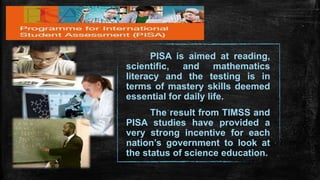Current trends in Science Education in Pisa Results reveal latest insights.
- Update Time : Sunday, May 5, 2024

Current trends in science education according to the Pisa results include a shift towards inquiry-based learning and a focus on developing students’ scientific literacy skills. Science education is critical in preparing students for the challenges of the 21st century.
As such, it is crucial to keep up with the latest trends in science education. The Pisa results, which provide a comprehensive assessment of student performance in science, have identified key trends in science education. These trends include a shift towards inquiry-based learning, where students learn by asking questions and conducting experiments.
Additionally, there is a growing emphasis on developing students’ scientific literacy skills, which involve the ability to understand and communicate scientific concepts. This article will explore the current trends in science education according to the Pisa results and their implications for the future of science education.
The Evolution Of Science Education
Science education is constantly evolving to keep up with current trends. Traditional approaches are being challenged by modern methods that incorporate technology in teaching. The Pisa results highlight the need for a shift towards innovative strategies that engage students and promote critical thinking. By embracing hands-on experiments and interactive learning tools, educators can foster a deeper understanding of scientific concepts. The integration of digital resources enables students to explore complex ideas in engaging and accessible ways. As science education continues to evolve, it is essential to embrace change and adapt to the dynamic landscape of 21st-century learning.

Credit: www.researchgate.net
Key Findings From Pisa
The PISA results have revealed interesting insights into the performance comparison across countries. The data shows a significant variation in the academic achievements of students globally. Moreover, the impact of socioeconomic factors on these results is noteworthy. The findings emphasize the need for a comprehensive approach to science education that addresses these disparities.
Embracing Inquiry-based Learning
Current Trends in Science Education in the Pisa Results: Embracing inquiry-based learning is essential in science education. It promotes curiosity and critical thinking, encouraging hands-on experiments. This approach fosters a deeper understanding of scientific concepts and encourages students to actively engage in the learning process.
Diversity And Inclusivity In Stem Education
Current Trends in Science Education in the Pisa Results: Diversity and inclusivity in STEM education are crucial. Addressing Gender Disparities: Encouraging girls to pursue STEM fields is essential. Providing support to underrepresented minorities is also important.
The Role Of Teachers In Shaping Science Education
Teachers play a crucial role in shaping science education, and current trends in science education reflect this. PISA results show that students perform better when their teachers are trained in science and use inquiry-based teaching methods. Effective science education depends on the quality of teaching.
| Professional Development Opportunities: Teachers need ongoing training. |
| Empowering Educators to Innovate: Encouraging creativity in lesson planning. |

Credit: www.slideshare.net
Fostering Collaboration And Interdisciplinary Learning
Science education is trending towards fostering collaboration and interdisciplinary learning, as seen in the recent PISA results. This approach encourages students to work together and apply knowledge from multiple subjects, preparing them for a future that requires diverse skill sets.
| Current Trends in Science Education |
| Science education now focuses on collaboration and interdisciplinary learning. |
| Connecting science with other subjects enhances student engagement. |
| Encouraging teamwork and problem-solving skills is a top priority. |
Adapting To The Digital Age
Current trends in science education focus on adapting to the digital age by utilizing online resources and platforms. Teachers are enhancing virtual labs and simulations to engage students in interactive learning experiences.
Future Directions In Science Education
Current Trends in Science Education are shaping the future of learning. Integrating Artificial Intelligence in Learning is revolutionizing the educational landscape. Teachers are preparing students for emerging fields by focusing on technology-driven skills.

Credit: www.academia.edu
Frequently Asked Questions
When Were The Most Recent Pisa Results?
The most recent PISA results were released in December 2019.
What Was The USA Pisa Result?
The USA PISA result showed average performance in reading, math, and science compared to other countries.
What Are The Results Of Pisa In Latin America?
PISA results in Latin America show mixed performance, with some countries improving while others lag behind.
What Are The Results Of The Finland Pisa Test?
Finland’s PISA test results consistently rank among the top in the world for student performance.
Conclusion
The PISA results highlight the need for innovative approaches in science education. Emphasizing critical thinking, digital literacy, and practical application can enhance student engagement and learning outcomes. By staying updated on current trends and leveraging technology, educators can better prepare students for the challenges of tomorrow’s scientific landscape.


















Leave a Reply